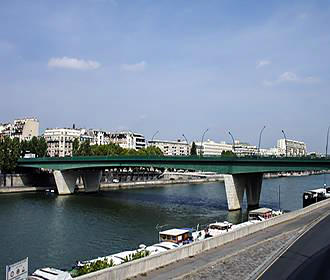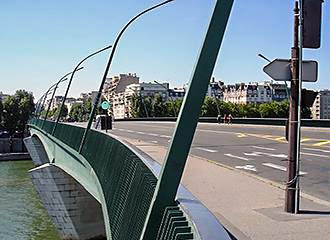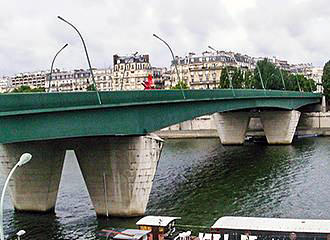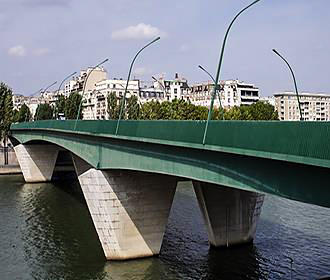Paris Pont du Garigliano bridge in France
Now the Paris Pont du Garigliano bridge in France is a very modern looking steel construction bridge over the River Seine, which is actually the highest bridge in Paris and was only constructed during the 1960s, which replaced an old viaduct at the same location.
Pont du Garigliano bridge history
There was once a ferry service located at this point between the 15th and 16th Arrondissements, yet this became insufficient with the weight of traffic increasing, and so it was decided that a bridge needed to be constructed.
There was also a need for a rail link, and therefore in the 1860s a stone bridge for road traffic along with a viaduct on top to accommodate the railway tracks was constructed, which was finished in 1865.
Resembling the Pont de Bercy, this new bridge was named the Viaduc du Point-du-Jour Viaduct, although it was sometimes referred to as the Viaduc d'Auteuil after the area of Paris that this two tier bridge stretched to.
On this viaduct in Paris, there were several arches going over the River Seine and unfortunately they were also far too low for barges to navigate when the river rose quite dramatically at certain times of flooding. And unfortunately it had to repaired on two separate occasions when it was severely damaged during the 1870 siege of Paris and again in 1943 during World War II when it was bombed.
But with the increased traffic utilising the Marechaux ring road around the city and the railway part now being disused, by the late 1950s it was decided that there were too many problems associated with the Viaduc du Point-du-Jour Viaduct, and it should be demolished and entirely replaced with a new bridge but in the same location.
About the Paris Pont du Garigliano bridge in France
This new modern Paris bridge was designed by the architect Davy and the engineer Thenault, and started in 1963 after the viaduct had been demolished the previous year, it was finished in 1966 and inaugurated on 1st September the same year with the name Pont du Garigliano.
The name chosen of Pont du Garigliano was in recognition of General Juin and the victory won in Italy during World War II, which is also often referred to as the Battle of Monte Cassino by the Garigliano valleys.
Pont du Garigliano bridge facts
Now, as you will see, the new Paris Pont du Garigliano bridge in France over the River Seine is purely a road bridge with a construction of six welded metal girders that comprise three spans in total with the largest slightly arched span being 93 metres, and this steel frame is covered by reinforced concrete.
It has two side spans of 58 metres that go over a road on each bank of the river, and the whole Paris Pont du Garigliano bridge in France is supported by very tall masonry piers located close to the banks to allow river traffic to navigate easily, and in fact, this means it is now the highest bridge in Paris.
Now the Paris Pont du Garigliano bridge in France is 26 metres wide, and has a very bland modern design with a green colour deck, yet for only a few years there was a piece of contemporary art in the form of a brightly coloured flower installed on one side of the bridge.
It was the idea of Sophie Calle in collaboration with Frank Gehry to be a telephone shaped as a flower, but had no real function, although this monumental sculpture in Paris was produced in recognition of the new tramway in Paris and the French artist herself could phone to see if any passersby would pick up the receiver!
Visiting the Paris Pont du Garigliano bridge in France
You will find the Paris Pont du Garigliano bridge in France stretching from the Quai d'Issy-les-Moulineaux in the 15th Arrondissement over the River Seine to the Quai Louis Bleriot in the 16th Arrondissement of Paris, and the bridge upstream is called the Pont Mirabeau, whereas the downstream bridge is the Pont Aval.
Now when it comes to accessing this area of the city, the nearest Paris Metro station is called the Balard stop via line 8, yet it is also a Tramway stop on line T3a, yet the nearest RER train station, named after the bridge, is called the Pont du garigliano stop serving line C.



